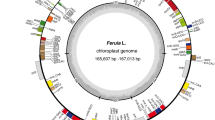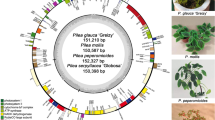Abstract
The sequences of the ITS (internal transcribed spacer) and 5.8S rDNA of three cultivated strains of Porphyra haitanensis thalli (NB, PT and ST) were amplified, sequenced and analyzed. In addition, the phylogenic relationships of the sequences identified in this study with those of other Porphyra retrieved from GenBank were evaluated. The results are as follows: the sequences of the ITS and 5.8S rDNA were essentially identical among the three strains. The sequences of ITS1 were 331 bp to 334 bp, while those of the 5.8S rDNA were 158 bp and the sequences of ITS2 ranged from 673 bp to 681 bp. The sequences of the ITS had a high level of homology (up to 99.5%) with that of P. haitanensis (DQ662228) retrieved from GenBank, but were only approximately 50% homologous with those of other species of Porphyra. The results obtained when a phylogenetic tree was constructed coincided with the results of the homology analysis. These results suggest that the three cultivated strains of P. haitanensis evolved conservatively and that the ITS showed evolutionary consistency. However, the sequences of the ITS and 5.8S rDNA of different Porphyra species showed great variations. Therefore, the relationship of Porphyra interspecies phyletic evolution could be judged, which provides the proof for Porphyra identification study. However, proper classifications of the subspecies and the populations of Porphyra should be determined through the use of other molecular techniques to determine the genetic variability and rational phylogenetic relationships.
Similar content being viewed by others
References
Alice L A, Campbell C S. 1999. Phylogeny of Rubus (Rosaceae) based on nuclear ribosomal DNA internal transcribed spacer region sequences. Am. J. Bot., 86: 81–97.
Bao S L, Ding X Y, Chang J, Shen J, Tang F. 2004. Identification of Traga Plants along middle-low reaches of Changjiang River by analyzing their DNA sequences. Chin. Tradit. Herbal. Drugs, 35(8): 926–930.
Baldwin B G. 1992. Phylogenetic utility of the internal transcribed spacers of nuclear ribosomal DNA in plants: an example from the composite. Mol. Phylogenet. Evol., 1: 3–16.
Baldwin B G, Sanderson M J, Porter J M, Wojciechowski M F, C S Campbell, Donoghue M J. 1995. The ITS region of nuclear ribosomal DNA: A valuable source of evidence on angiosperm phylogeny. Ann. MO. Bot. Gard., 82: 247–277.
Blomster J, Hoey E M, Maggs C A, Stanhope M J. 2000. Species-specific oligonucleotide probes for macroalgae: molecular discrimination of two marine fouling species of Enteromorpha (Ulvophyceae). Mol. Ecol., 9: 177–186.
Cai J N, Zhou K Y, Xu L S, Wang Z T, Shen Y, Wang Y Q, Li X B. 2000. Ribosomal DNA ITS sequence analysis of Cnidium monnieri from different geographical origin in China. Acta Pharm. Sin., 35: 56–59.
Cerbah M, Souza-Chies T, Jubier M F, Lejeune B, Siljak-Yakovlev S. 1998. Molecular phylogeny of the Genus Hypochaeris using internal transcribed spacers of nuclear rDNA: inferences for chromosomal evolution. Mol. Biol. Evol., 15(3): 345–354.
Chen L L, Kong X Y, Zhou L S, Chen L M, Yu Z N. 2005. Sequence analysis of ribosomal DNA internal transcribed spacers of bloody clam, Scapharca broughtonii. J. Fish. Sci. Chin., 12: 104–107.
Ding X Y, Wang Z T, Xu H, Xu L S, Zhou K Y. 2000. Database establishment of the whole rDNA ITS region of Dendrobium species of “Feng-dou” and authentication by analysis of their sequences. Acta Pharm. Sin., 37(7): 567–573.
Dover G A. 1982. Molecular drive: a cohesive mode of species evolution. Nature, 299: 111–117.
Elder J R, Turner B J. 1995. Concerted evolution of repetitive DNA sequence in eukaryotes. Q. Rev. Biol., 70: 297–319.
Fan X L, Fang Y J, Hu S N, Wang G C. 2007. Generation and analysis of 5318 expressed sequence tags from the filamentous sporophyte of porphyra haitanensis (Rhodophyta). J. Phycol., 43(6): 1 287–1 294.
Gonzalez I L, Sylvester J E, Smith T F, Stambolian D, Schmickel R D. 1990. Ribosomal RNA gene sequences and hominoid phylogeny. Mol. Biol. Evol., 7: 203–219.
Guo B T, Bi Y P, Shan L, Li G C, Dai J X. 2000. Extraction of plasmid-like DNA and high-quality total DNA from Porphyra yezoensis. Acta Oceanol. Sin., 22(2): 87–91.
Hall T A. 1999. BioEdit: a user friendly biological sequence alignment editor and analysis program for Windows 95/98/NT. Nucl. Acids Symp. Ser., 41: 95–98.
Hillis M D M, Davis S K, 1988. Ribosomal DNA: Intraspecific polymorphism, concerned evolution and phylogeny reconstruction. Syst. Zool., 37: 63–66.
Jia J H, Wang P, Jin D M, Qu X P, Wang Q, Li C Y, Weng M L, Wang B, 2000. The application of RAPD markers in diversity detection and variety identification of Porphyra. Acta Bot. Sin., 42: 403–407.
Kumar S, Tamura K, Jakobsen I B, Nei M. 2001. MEGA 2: molecular evolutionary genetics analysis software. Bioinformatics, 17: 1 244–1 245.
Kunimoto M, Kito H, Kaminishi Y, Mizukami Y, Murase N. 1999. Molecular divergence of the ssu rRNA gene and internal transcribed spacer 1 in Porphyra yezoensis (Rhodophyta). J. Appl. Phycol., 11: 211–216.
Kyosuke N, Yusho A. 2003. Rapid DNA extraction from conchocelis and ITS-1 rDNA sequences of seven strains of cultivated Porphyra yezoensis (Bangiales, Rhodophyta). J. Appl. Phycol., 15: 29–35.
Leskinen E, Pamilo P. 1997. Evolution of the ITS sequences of ribosomal DNA in Enteromorpha (Chlorophyceae). Hereditas, 126: 17–23.
Li X Y, Peng J Y, Bai R X. 2005. Use of ITS sequences Based on Nuclear rDNA for Phylogenetic Research of Seed Plants. Acta Bot. Boreal. Occident. Sin., 25(4): 829–834.
Ma J H, Xu P, Zhu J Y. 2005. Marin Rhodophyta Genetics-Porphyra. In: Zhang X C, Ma J H, Qin S and Xu P, ed. The Genetic of Marine Algae. Chinese Agriculture Press, Beijing, China. p. 185–186.
Ma X J, Wang X Q, Xiao P G, Hong D Y. 2000. Comparison of ITS sequences between wild ginseng DNA and garden ginseng DNA. Chin. J. Chin. Mat Med., 25: 206–209.
Mizukami Y, Okauchi M, Kito H, Kobayashi M. 1996. Discrimination of laver cultivars with RAPD markers. Fish. Sci., 62(4): 547–551.
Mizukami Y, Kito H, Kaminishi Y, Murase N, Kunimoto M. 1999. Nucleotide sequence variation in the ribosomal internal transcribed spacer regions of cultivated (cultivars) and field collected thalli of Porphyra yezoensis. Fish. Sci., 65: 788–789.
Morales V M, Pelcher L E, Taylor J L. 1993. Composition of the 5. 8S rDNA and internal transcribed spacer sequences of isolates of Leptos phaeria maculans from different pathogenicity groups. Curr. Genet., 23: 490–495.
Pang G X, Wang G C, Hu S N, Zeng C K. 2005. Acquirement and analysis of expressed sequences tags of filamentous sporophyte of Porphyra haitanensis. Oceanol. Limnol. Sin., 36(5): 452–457.
Shi Q L, Zhu G Q, Huang M R. 2001. The principal of molecular systematics and the application in forest tree. Chin. Bulletin Life Sci., 1: 90–91.
Steane D A, Scotland R W, Mabberley D J, Olmstead R G. 1999. Molecular systematic of Clerodendrum (Lamiaceae): ITS sequences and total evidence. Am. J. Bot., 86(1): 98–107.
Sun X, Yang R, Liu B Q, Pei L Q. 2006. Sequence analyses of rbcS and rbcL-rbcS intergenic spacer region in laver Porphyra haitanensis. Fish. Sci., 25(1): 24–26.
Tang B P, Zhou K Y, Song D X. 2002. Application of sequences of nrDNA ITS to molecular systematics of invertebrates. Chin. J. Zool., 37: 67–73.
Thompson J D, Gibson T J, Plewniak F, Jeanmougin F, Higgins D G. 1997. The Clustal X windows interface: flexible strategies for multiple sequence alignment aided by quality analysis tools. Nucl. Acids Res., 24: 4 876–4 882.
Wang X Q, Hong D Y. 1997. Progress in molecular systematics of plants in recent five years. Acta Phytotax. Sin., 35(5): 465–480.
Wang Y, Liu B Q, Luo Q J, Fei Z Q, Pei L Q, Xue Q Z. 2000. RAPD Analysis of genetic variation among Porphyra haitanensis strains. J. Ocean. Univ. Qingdao, 30(2): 225–229.
Wei Q. 1999. Molecular biology laboratory procedure. Springer Press and Higher Education Press, Beijing, China. p. 53–56. (in Chinese)
Xiang Q P, Xiang Q Y, Liston A, Fu L G, Fu D Z. 2000. Length variation of the nuclear ribosomal DNA internal transcribed spacer in the genus abies, with reference to ITS systematic utility in Pinaceae. Acta Bot. Sin., 42(9): 946–951.
Xie C T, Ji D H, Chen C S, Xu Y, Zhang Y. 2007. Application of ISSR markers in germplasm identification of different color’s Porphyra haitanensis filament strains. J. Fish. Chin., 31(1): 105–112.
Xu T J, Liu C W, Liu L, Dong Q F and Yang Y X. 2006. The application of internal transcribed space (ITS) in germplasm identification and the genetic diversity analysis of the aquatic animal. J. Zhanjiang. Ocean. Univ., 26: 84–88.
Yang J, Wang Q, Liu M H, An L J. 1999. A simple method for extracting total DNA of seaweeds. Biotechonl., 9(4): 39–42.
Yang R, Liu B Q, Luo Q J, Wang Y J, Zhou X C, Dai J X. 2002. Genetic variation of Porphyra haitanensis by applying AFLP. High Technol. Lett., 12: 83–86.
Yoshida T, Notoya M, Kikuchi N, Miyata M. 1997. Catalogue of species of Porphyra in the world, with special reference to the type locality and bibliography. Nat. Hist. Res. (Special Issue), 3: 5–18.
Zhang B Y, Wang G C, Lv S H, Qi Y Z, Zou J Z, Zeng C K. 2006. The cloning and sequence analysis of the 5.8S rDNA and ITS region from three strains of marine diatoms. Acta Oceanol. Sin., 28: 111–117.
Author information
Authors and Affiliations
Corresponding author
Additional information
Supported by the National Natural Science Foundation of China (No. 40576074), and the Key Laboratory of Experimental Marine Biology, Institute of Oceanology, Chinese Academy of Sciences (No. KFN92007NO1)
Rights and permissions
About this article
Cite this article
Li, Y., Shen, S., He, L. et al. Sequence analysis of the ITS region and 5.8S rDNA of Porphyra haitanensis . Chin. J. Ocean. Limnol. 27, 493–501 (2009). https://doi.org/10.1007/s00343-009-9168-1
Received:
Accepted:
Published:
Issue Date:
DOI: https://doi.org/10.1007/s00343-009-9168-1




